 |
Landguard Fort
Felixstowe, Suffolk, UK
|
|
 |
Constructed: 1744-1750,
1870-1890
Used by: Great Britain
Conflicts in which it participated:
Second Anglo-Dutch War
(in an earlier incarnation)
|
In case some of us have not yet noticed, the United Kingdom is an island. While this has historically been beneficial to that frequently-at-war nation in some respects (no direct borders with hostile neighbors), it must have been a nightmare in others (enormous coastline to defend). |
 |
|
|
When England was in conflict with other seafaring nations (as it was, more or less constantly, for centuries), how could it determine what part of it's 11,000+ miles of coastline to defend? A seaborne enemy could notionally land anywhere it chose, but those potential landing sites were somewhat predictable. That the United Kingdom remains the United Kingdom proves that it had some idea of what it were doing.
|
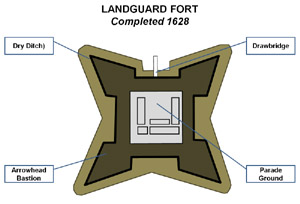 
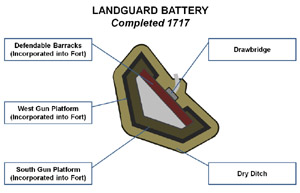 
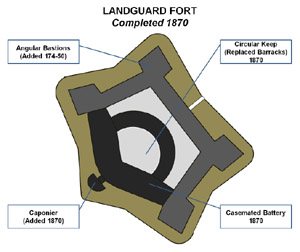 Landguard Fort through the years. These images come to us courtesy of Castlesfortsbattles.co.uk, which has a great Languard Fort page. Landguard Fort through the years. These images come to us courtesy of Castlesfortsbattles.co.uk, which has a great Languard Fort page. |
 |
Take, for example, Dover. As the point where Great Britain is closest to Europe, and the southern tip of the Thames Estuary (where the Thames River connects London to the wider world) Dover was an obvious landing zone for nautical invaders. As such, over the centuries Dover was speckled with such exciting fortifications as Deal Castle, Drop Redoubt and a host of other defensive works. Actually, forget Dover, because we're talking about Landguard Point at Felixstowe, which could be loosely described as being in the vicinity of the northern tip of the Thames Estuary...or more accurately, at the mouth of the Rivers Stour and Orwell, which join to create a valuable deepwater harbo(u)r at Harwich. Though perhaps not as desirable a conquestatory destination as the mouth of the Thames, Felixstowe was plenty close enough for a pleasant day's naval invading activity for France, and it's an even more convenient British ingress for Holland. Much English fortbuilding was initiated by King Henry VIII (1491-1547)'s charming inability to imagine that their might be any sort of limit to his personal gratification (if a wholly understandable desire to continue his lineage with a male heir can be construed as "personal gratification"). Henry infuriated the crowned heads of Europe by declaring himself head of the English Church, which he did in order to make it possible for him to marry and unmarry the persons of his choosing, at the rate of his choosing. Those other European crowned heads didn't need much in the way of infuriating under the best of circumstances, and Henry rejecting the authority of the Pope was an excellent circumstance at which a crowned head might take umbrage. England was suddenly at immediate risk of invasion from France, Spain and whomever else felt it to be politically expedient to be outraged at the time. And what does any responsible monarch do when foreign invasion threatens his (or her) soil? Build starforts, of course! |
|
Only this took place in the early 16th century, so there really weren't starforts yet...at least not in England. Early starforts had been built in Italy starting at the very end of the 15th century, and all of Europe (plus England, who will tell you that they are absolutely not part of Europe) knew of, and were intrigued by this mind-blowing engineering breakthrough, but actual first-hand knowledge of how these new forts were built, or even what they looked like, was hard to come by. The Italians certainly had a vested interest in keeping this information to themselves for as long as possible, even if ultimately that secret wasn't kept for long at all. In 1534 Henry signed a Device, or act, proclaiming that an era of unprecedented fortbuilding for the defense of the realm had begun. This resulted in a series of Device Forts, the most stellar example of which may have been the aforementioned Deal Castle at Dover. The largest forts that came about during this period weren't starforts per se, in fact they more closely resembled delicious multilayered cakes, but they took into account some of the bastioned theory of the starfort, as was understood at the time in England. |
But we're talking about Felixstowe, contrary to what you've been reading for the past several paragraphs. The peninsula south of Felixstowe benefited from Henry's Device in the form of three circular, earthen artillery emplacements, or bulwarks, with two more at Harwich across the mouth of the river, all of which were constructed in 1539.
Would a series of 1530's cannon have been able to do much more to prevent an invasion than make noise and endanger their own crews? Henry must have thought so. Regardless, the hoped-for Spanish and/or French invasion never materialized, so those earthen rings around cannons were abandoned in the 1550's and melted away, unloved.
But by the 1580's, things betwixt England and Spain were heating up again, for much the same reasons: England's Queen Elizabeth I (1533-1603) reinstituted the Anglican Church's dominion over her kingdom, which got Spain's King Philip II (1527-1598)'s knickers back in the same ole twist. Invasionmania restored!
|
 |
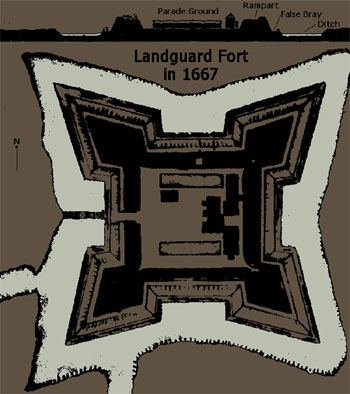 The first starfort version of Landguard Fort, from an informational plaque at the fort. Thanks, Fortified-Places.com! The first starfort version of Landguard Fort, from an informational plaque at the fort. Thanks, Fortified-Places.com! |
|
A substantial-sounding stone blockhouse may or may not have been built at Landguard Point (sources differ), large enough to be defended by 46 guns. Big blockhouse! Or very small guns. Or quite possibly both. This possible blockhouse and its surrounding improved bulwarks were manned at the time of the Spanish Armada debacle of 1588, but sadly saw no Spaniards.
Despite this strategic location being fortified for several decades but never attacked, the decision was made to get serious about its defense in the early 17th century. A half-moon battery was built at Harwich in the 1620's, and in 1625 work began on the first starfort on Landguard Point. This fort was completed in 1628, and had the textbook lines of a four-bastioned starfort. 62 guns lined its walls and bastions, and 'twas big enough to hold a garrison of "several hundred" men.
|
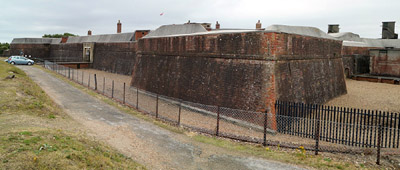 Landguard's northern bastion today. Well, probably not today today. But very recently. Landguard's northern bastion today. Well, probably not today today. But very recently. |
 |
But a starfort is like a flower, small child or petulant female (not that I have ever known any petulant females), in that it needs care and attention to flourish, and Landguard Fort was provided with neither. It was fully manned in times of crisis, such as throughout the English Civil War (1642-1652), but nobody bothered to maintain it.
Fortunately for English starforts, the Second Anglo-Dutch War (1665-1667) did not go well for England. |
|
The Dutch and English competed for much trade all around the explored globe, and while each was at war with whatever other European power took their fancy (as frequently was the case), they found that the seas were big enough for both of their trading interests to proceed more or less unhindered by the other. But once there was peace, both England and Holland had more ships available to dart about and get in the way of each others' mercantile ambitions...and as this was not an era in which peaceful negotiation was held in much esteem, war it had to be.
After some initial victories at sea, England found itself unable to pay to keep its full fleet in action, of which circumstance the Dutch were only too happy to take advantage. In June of 1667 a Dutch fleet staged an assault down the River Medway, which meets the Thames Estuary just south of the River Thames itself. Over a period of six days, the Dutch captured the fort at Sheerness at the river's mouth, bashed their way through a massive chain spread across the river to prevent just such events as this, and made it nearly 20 miles inland before the home team got its act together and forced them to turn around and head back to sea.
|
The Raid on the Medway was such a success for the Dutch that they followed it up with a series of other raids on Britain's western shores, including a twelve-ship investment at Harwich, in July of 1667. Their aim was to burn the ships in the Royal Navy Dockyard at Harwich and generally wreak havoc in whatever way possible, but the Starfort Of Our Current Interest stopped them in their tracks. Or more accurately stopped them in their wakes, since we're talking about a fleet.
The embarrassment and panic caused by recent events elicited a flurry of activity at the dilapidated fortifications along England's western coast, and Landguard Fort received some just-in-time improvements.
|
 |
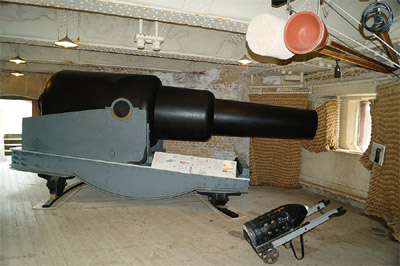 A huge RML (Rifled Muzzle Loading) Gun in Landguard Fort's Casemated Battery. This battery wasn't added until 1870, but doubtless the fort's defenders wished they had some RML's when the Dutch attacked in 1667. Sure, the English artillerists of 1667 would have had no idea what to do with an RML, but it sure would've looked scary. A huge RML (Rifled Muzzle Loading) Gun in Landguard Fort's Casemated Battery. This battery wasn't added until 1870, but doubtless the fort's defenders wished they had some RML's when the Dutch attacked in 1667. Sure, the English artillerists of 1667 would have had no idea what to do with an RML, but it sure would've looked scary. |
|
The Dutch landed 800 Marines at Felixstowe and attacked the recently-enhanced Landguard Fort, whose 200 defenders were able to heroically and violently dissuade the invaders from further Felixstowian or Harwichian adventures.
As Landguard Fort had single-handedly saved all of England from a dreadful fate of speaking Dutch, it was universally praised and maintained at a peak state of readiness from that day forward. Not really! The instant the Dutch had been repelled, Landguard Fort was again forgotten, and permitted to once again slide into mournful disrepair...so much so that, the next occasion on which most of Europe declared mutual war on itself in 1701 (this being the War of the Spanish Succession (1701-1714)), our fort was so far gone it was considered unworthy of repair. A sad, sad, state of affairs.
|
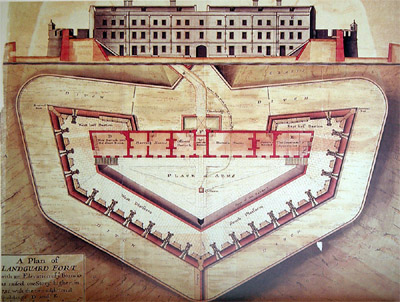 Landguard Fort's 1717 addition. Thanks again Fortified-Places.com, you are a wealth of priceless information that I wish was still being updated! Landguard Fort's 1717 addition. Thanks again Fortified-Places.com, you are a wealth of priceless information that I wish was still being updated! |
 |
A new fortification system was planned for Harwich, a supporting battery for which was built just to the south of poor forsaken Landguard Fort, from 1717 to 1720. The Harwich fortification program never got past the planning stage, however, and though Landguard Battery was never intended to replace its namesake fort, it was upgraded in the early 1730's to mount heavier guns. This was a wedge-shaped brick flankless fort, really just a fortified battery, with a single gun deck.
Fortunately for lovers of English fortification of this era, one never had to wait terribly long for there to be a reason to build more of them. The Jacobite Rising of 1745, which involved French King Louis XV (1710-1774) in the business of an attempted reclamation of the English throne for the House of Stewart, was one such reason. |
|
War with France as always meant British invasion jitters, and thus the Crown was finally willing to part with some poundage for the defense of its Royal Navy Dockyard at Harwich. Construction on what was almost the final version of Landguard Fort began in 1744. As the four-bastioned previous design had proven pointy enough to withstand the Dutch in 1667, it was reasoned that a five-bastioned fort might vanquish invading foes the instant they set eyes on it! Landguard Battery was integrated into some of the new fort's curtain walls.
|
War with yet another seafaring nation was the genesis of yet another round of invasion-related nailbiting. The American Revolutionary War (1775-1783) brought the American Continental Navy into existence, and while it was a puny force compared to the mighty Royal Navy, it made up for its lack of numbers with verve and audacity. American Commander John Paul Jones (1747-1792) sailed the Ranger around the British Isles in 1778, raiding towns, disrupting merchant shipping and causing no small amount of official English consternation.
A series of earthwork batteries and trenchworks were added at and around Landguard Fort, and by the early 1780's the entire peninsula below Felixstowe was essentially a walled-off fortification, a defended camp, intended to serve as a protected base for land operations should Harwich come under attack.
|
 |
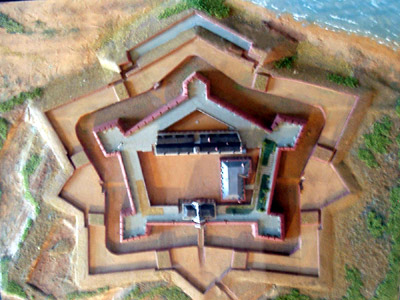 Landguard Fort in 1750. Its most striking entity is its barracks, which is that big black thing aligned horizontally within. The Governor's House is the other large structure hogging valuable parading space on the parade ground. Landguard Fort in 1750. Its most striking entity is its barracks, which is that big black thing aligned horizontally within. The Governor's House is the other large structure hogging valuable parading space on the parade ground. |
|
The overwhelming American invasion of Great Britain didn't happen, and in what by now we are recognizing to be a predictable pattern, maintenance of the Defended Camp on Landguard Point ceased in 1782, and its proud earthworks were allowed to melt away.
European enmity continued unabated into the 19th century, with Napoleon (1769-1821) representing the greatest threat to England since the last greatest threat to England.
|
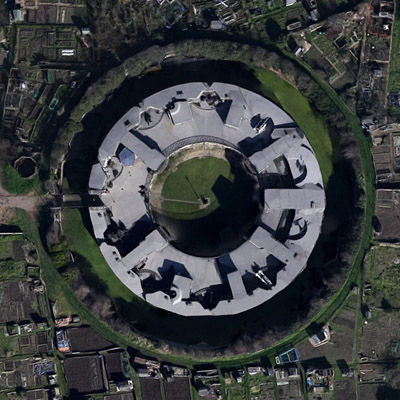 Harwich Redoubt, built in 1808. Harwich Redoubt, built in 1808. |
 |
A circular fortification, Harwich Redoubt, was built on the western side of the inlet, in 1808. Martello Towers, the concept of which vaguely infuriated me until I visited and was impressed by Fort East Martello (which isn't really a Martello Tower in the English sense) on Key West, were also sprinkled about like magic fortification dust in the vicinity of the Royal Navy Dockyard. Landguard Point received some spiffing up as well in this period, with new guns being added to the fort and Beauclerk's Battery, which had been added near Landguard Fort in 1753. The scourge that was Napoleon was ultimately contained on the continent, and Britain retained it's Uninvaded-For-Nearly-150-Years status. Relative peace followed for the next few decades...aside from various colonial altercations, which didn't really count in the grand scheme of British things as far as a need to fortify the homeland. |
|
The overwhelming superiority of the Royal Navy in the post-Napoleonic era made the British Empire perfectly happy to ignore its coastal fortifications: Whom, after all, would have the wherewithal to attack British shores? Whom, I say? WHOM?!
The answer to that particularly impolitely bellowed query turned out to be, unsurprisingly, France. In 1859 the French Navy unveiled the Gloire, the world's first oceangoing ironclad warship. Though particularly hideous in appearance, the introduction of the Gloire rendered obsolete everything in the Royal Navy's inventory at a stroke, and coupled with Napoleon III (1808-1873)'s loudly proclaimed imperial ambitions was an unpleasant British wakeup call.
|
British fortbuilding was suddenly in vogue once again! New forts began popping up at Great Britain's strategic locations in the 1850's (such as those on the island of Alderney), and in 1860 Prime Minister Lord Palmerston (1784-1865) declared his intention to turn the entire coast of Great Britain into a nonstop masonry wall, spiked with enormous guns. Well, almost. A series of fortifications known as the Palmerston Forts were built at several locations through the 1860's, at an enormous expense that the Prime Minister's many detractors felt unjustified. |
 |
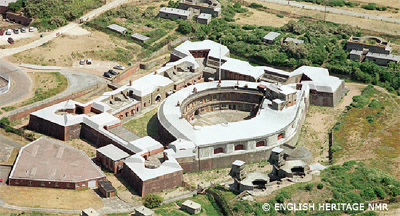 Landguard Fort, present day. Picture provided by English Heritage, Now Mighty Recalcitrant. Landguard Fort, present day. Picture provided by English Heritage, Now Mighty Recalcitrant. |
|
But, being the single-issue voter that we are, we feel that Lord Palmerston was a fine Prime Minister, whose head was screwed on correctly regarding the all-important matter of fortification. Initial Palmerstonian plans for the defense of the Royal Navy Dockyard at Harwich were limited to a new 14-gun battery at Shotley Point inside the harbor, and improvements to Harwich's Martello Towers...but the authorities came to their senses in 1870 and began work on a serious upgrade to Languard Fort.
|
|
 |
I have frequently decried the unholy besmirchment of some American starforts during the Endicott Period of the 1890's, portions of whose majestic masonry were enhanced in a slapdash manner with great loads of markedly un-majestic steel and concrete so as to mount heavier guns. While this is similar to what happened to Landguard Fort in the 1870's, it's difficult not to be pleased with the result. The last remnants of the 1717 Landguard Battery were razed, and Landguard Fort's business end was made into an armored, casemated battery...with a stumpy little caponniere jutting out afront. |
|
Landguard's new battery had seven casemates along its top floor, within each of which was an enormous RML (Rifled Muzzle Loading) Gun. Additional RML's were added to some of the fort's remaining bastions, which were strengthened with concrete. The new battery also served as the fort's magazine, officer's quarters and barracks, and would function as the fort's citadel in the unlikely event that the outer walls were overrun.
The end result was much the same as what would occur across the Atlantic, but the difference is that Britain's military engineers completed Landguard Fort's upgrade utilizing a sense of style and proportion with which their later American counterparts didn't bother. While Landguard Fort lost one of its five sacred starfort bastions in the 1870 upgrade, the new battery retains the symmetry of the overall design of the fort, and any time you're adding casemates to anything, you're doing God's work. This, Landguard Fort's last major overhaul, was completed in 1890.
|
By which time, forts such as Landguard were considered passé. Swift improvements in naval artillery, plus the advent of smaller, more nimble warships, made the seacoast starfort, with its relatively small number of large, slow-loading guns, a semi-useful artifact of days gone by. Our fort remained in service, however, with a web of electrically-fired mines being strung across the waterway, with supporting searchlights going up in the late 1870's; additional batteries for new breechloading guns built just outside the fort at the tail end of the 19th century; a control post added to the fort's roof in the early stages of the First World War (1914-1918), to direct shipping in the harbor.
|
 |
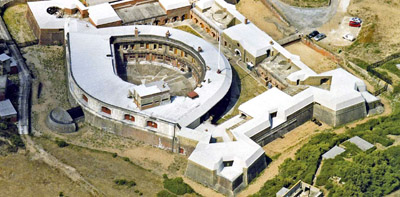 Landguard Fort's southern and eastern bastions are now pillboxes! Way to utilize those bastions in a modern fashion without uglying them up, Britain! Landguard Fort's southern and eastern bastions are now pillboxes! Way to utilize those bastions in a modern fashion without uglying them up, Britain! |
|
This latter addition made Landguard Fort a worthy target of the Kaiser's wood-and-fabric Luftstreitkräfte, or air service. Accordingly, a group of German bombers paid a visit to Landguard in July of 1917...but little damage must have resulted, as I have found no mention of any. Landguard Fort was the control center for the busy bustle that was Harwich Haven during the Second World War (1939-1945), and the second wave of the D-Day invasion in June of 1944 disembarked from Harwich.
In 1956, the coastal artillery arm of the British military was disbanded, and our fort was abandoned in 1960. A restoration effort got underway in 1990, and today Landguard Fort is a buzzing hive of visitors and historical reenactors. Exhibits at the fort reach back to the 16th century, Landguard Point's earliest days as a defensive entity.
|
|
|
|
|
|
 |




